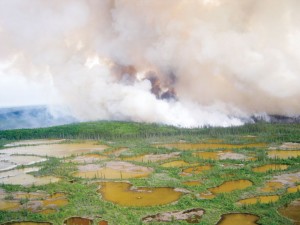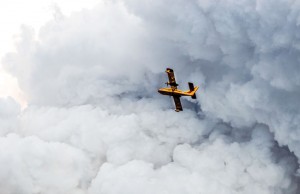by Don Jaque – Northern Journal, Fort Smith, Canada— June 10, 2013 at 6:32 PM
Photo: ENR NWT – The fire on top of Salt Mountain approximately 30 km west of Fort Smith grows to 1,100 hectares on Wednesday evening due to a cold cell and gusting winds that sent embers across the highway out of Wood Buffalo National Park.
For the second time in less than 11 months, a major campaign fire on Salt Mountain within 35 km of Fort Smith brought that community to a high state of alert, followed by relief after it was expertly controlled.
Last summer in late July, a multi-jurisdictional fire that started in Wood Buffalo National Park involved Alberta, NWT and national park resources in a campaign fire pushed by wind. Fire crews managed to corral it just as it threatened to cross Hwy 5 and take out the power lines from Taltson Dam that serve Fort Resolution, Enterprise and Hay River and potentially even turn towards Fort Smith. The fire was contained right at the highway with textbook-like precision.
The current fire started June 1 due to lightning in the park, burning slightly southwest of the 2012 burn, just south of Hwy 5. Over several days, Parks Canada crews from Wood Buffalo and three other national parks worked the fire on the ground, assisted by choppers with buckets and tankers of retardant from Alberta and the NWT.
On the night of June 3, the fire grew dramatically overnight. Crews performed a successful burnout operation along the highway to clean out fuels it might feed on if it turned that way to cut off the road and even burn the power lines. It was well contained and under control at that point.
Mother Nature decided to trump all that, however. On June 5, the weather changed and a cold front moved in, generating high winds from the south. By the afternoon, the fire had jumped the highway.
Photo: Patrick Pennycook – A GNWT water bomber heads through a thick cloud of smoke during control efforts on Wednesday evening.
“A spot inside the fire flared up and embers travelled across Hwy 5,” commented Jean Morin, fire program manager for Wood Buffalo National Park. He said the embers flew nearly a kilometre from well inside the fire, over the burnout, and started a new fire on the north side of the highway. It moved quickly.
“With the wind, the spread of the fire was very fast,” Morin said.
He said they bucketed the fire with the Parks Canada choppers and the NWT government called in air tankers to lay down retardant. The fire got into pine and spruce forest along the road to the Foxholes Prairies, producing a massive smoke column in the afternoon sky.
The fire then became an NWT challenge and crews from Fort Providence, Fort Liard, Inuvik and Hay River joined Fort Smith crews on the ground and hit it hard. Retardant lines were laid down by air tankers to protect the nearby settlement of Salt River. Five bulldozers were contracted to create a fire guard that protected both Salt River and the Foxholes Prairies where several pair of whooping cranes nest.
In the middle of the rampaging wildfire was an encampment of heavy equipment belonging to Aurora College, sitting in a gravel quarry near the Foxholes road where the college runs on-site training for a Thebacha Campus Heavy Equipment Operator course. College staff were forced to abandon the work site as soon as news came of the fast moving fire. There was fear all that expensive equipment might be lost.
Fortunately, all equipment survived unscathed. The Caterpillar tractors, loader and excavator were parked in the centre of a large gravel pit and the fire burned around and past it.
Cool weather subsequently helped the firefighters’ cause and with rain June 6, the blaze, after six action-packed days, was finally brought under control.



